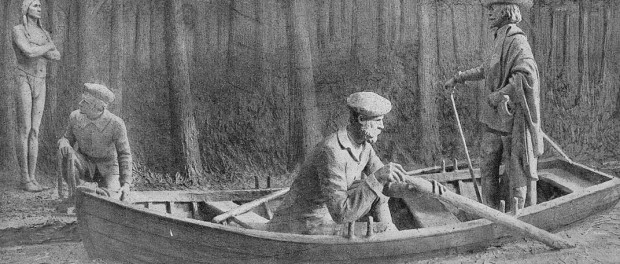A Little History of Quebec Legal Systems & Other Quebec Curios
 Jacques Cartier meets Chief Donnaconna, butter sculpture style. Part of the Franco-British Exposition in London in 1908. Source: Private collection/Wikimedia Commons.
Jacques Cartier meets Chief Donnaconna, butter sculpture style. Part of the Franco-British Exposition in London in 1908. Source: Private collection/Wikimedia Commons.
It’s Cartier’s fault, of course. Or maybe Champlain. Whether you count the discoverer or the first colony builder/explorer, it is partly their fault that Quebec has two legal systems. In fact, Quebec is the only province in Canada to have two legal systems: common and civil law. Common law, derived from English law, is the predominant law in the Rest of Canada, with a capital R. Civil law, on the other hand, derives from Quebec’s French past (and arguable present, although heavily modified). It is with civil law that this story begins. But step back a bit further to the wild west (of Europe).
The first successful settlement in what is now Quebec City was in 1608, founded by Samuel de Champlain. The population then was a whopping 28 people (read: men). Prior to this attempt, there were many other attempts by the French to settle, including a trading post at Tadoussac, but after a harsh, arguably Canadian winter, few men survived. Quebec City was slightly more successful, attaining a population of about 350 by the mid-sixteen hundreds. But for the most part, this new colony was a free-for-all, being ruled in part by the governor (Champlain, of course, who was responsible for “diplomacy”) and the Company of One Hundred Associates, a fur trading company that had been granted a monopoly over the place. That is, until 1663, when Louis XIV finally decided to take it all over. Coincidentally, the Company of One Hundred Associates went out of business the same year.
In 1664, at the young age of twenty-six, Louis XIV took a new interest in the colony. The territory that is now Quebec was part of the larger colony of New France, whose territory extended as far south as Louisiana and west into Alberta, and it had to be governed somehow. The King issued a decree proclaiming that the law of the new colony would mostly be based on the customary laws of Paris, the rudimentary beginnings of civil law. The customary laws of Paris had been the norm in France as a whole, the customary laws to trump all other customary laws, since the 1500s. As for written laws, it would be up to the King and his counsel that would decide which specific French laws he would want to apply to the colony by a case by case basis. With a growing colony, laws to govern the colony began to be put into place, and a new administrative system as well: there was now a governor, responsible for the military aspect of the colony, and an intendant, responsible for most other things.
There was also a rudimentary justice system, first in the form of Seneschals (a type of administrator responsible for justice), then in the form of courts (no appeals yet). As more people settled into the colony, the seigneurial system (the system in which lands were divided and administered) also became a local justice system, along with the ecclesiastic courts, and gradually, with the localisation of French laws and customs, people realised that New France might just be a bit different from back home.
But the beginnings of a civil law tradition is, like this column, only part one of two. The rest comes with the French and Indian War. It is this series of North American wars, part of the larger Seven Years’ War, that helped decide the development of the bi-judicial system.





